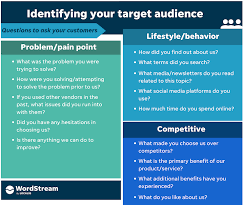The Significance of Target Audience Analysis in Marketing
Target audience analysis is a crucial component of any successful marketing strategy. By identifying and understanding your target audience, you can tailor your messaging, products, and services to meet their specific needs and preferences. This not only helps in reaching the right people but also in building long-lasting relationships with them.
Why is Target Audience Analysis Important?
**Precision**: Knowing your target audience allows you to create targeted campaigns that resonate with their interests and behaviours. This precision leads to higher engagement and conversion rates.
**Cost-Effectiveness**: By focusing your marketing efforts on a specific audience segment, you can avoid wasting resources on irrelevant leads. This targeted approach ensures that every pound spent contributes to meaningful results.
**Personalisation**: Understanding your target audience enables you to personalise your messaging and offers, making your brand more relatable and appealing to potential customers.
How to Conduct Target Audience Analysis
**Demographic Data**: Start by collecting basic demographic information such as age, gender, income level, education, and location. This data provides a foundation for understanding who your audience is.
**Psychographic Insights**: Dive deeper into the psychographics of your audience – their values, beliefs, interests, and lifestyle choices. This information helps in creating more targeted and compelling marketing messages.
**Behavioural Patterns**: Analyse the online behaviour of your target audience – what websites they visit, what content they engage with, and how they interact with social media platforms. This data can guide your digital marketing strategies effectively.
The Benefits of Effective Target Audience Analysis
Analyzing your target audience not only improves the efficiency of your marketing efforts but also enhances customer satisfaction and loyalty. By understanding what drives their purchasing decisions and how they prefer to engage with brands, you can tailor your approach for maximum impact.
4
- What are the 4 types of target audience?
- What is an example of target analysis?
- Why do we do target audience analysis?
- How do you evaluate the target audience?
What are the 4 types of target audience?
When it comes to target audience analysis, understanding the four main types of target audiences can provide valuable insights for crafting effective marketing strategies. The four types typically include demographic, geographic, psychographic, and behavioural audiences. Demographic audience segmentation focuses on characteristics such as age, gender, income level, and education. Geographic segmentation considers factors like location and climate. Psychographic segmentation delves into the values, interests, and lifestyles of the audience. Behavioural segmentation looks at consumer behaviour patterns like purchasing habits and online interactions. By identifying and analysing these different types of target audiences, businesses can tailor their messaging and offerings to better connect with their desired customer base.
What is an example of target analysis?
An example of target audience analysis could involve a company that sells high-end skincare products. Through detailed research and data collection, the company identifies its target audience as affluent women aged 30-50 who are interested in luxury beauty products and value natural ingredients. By understanding this demographic’s preferences, lifestyle choices, and purchasing behaviours, the company can tailor its marketing campaigns to resonate with this specific audience. This targeted approach may include creating personalised skincare recommendations, showcasing testimonials from similar customers, and promoting exclusive product launches through channels that appeal to affluent women interested in luxury beauty. Ultimately, this example illustrates how target audience analysis can help businesses refine their strategies to effectively reach and engage with their ideal customers.
Why do we do target audience analysis?
Target audience analysis is a fundamental practice in marketing that serves as the compass guiding businesses towards their desired goals. By delving into the intricacies of target audience analysis, organisations gain invaluable insights into the preferences, behaviours, and needs of their potential customers. This understanding allows businesses to create tailored marketing strategies that resonate with their target audience, leading to enhanced engagement, increased brand loyalty, and ultimately, improved business outcomes. In essence, target audience analysis empowers businesses to make informed decisions, maximise their marketing efforts, and forge meaningful connections with the people who matter most – their customers.
How do you evaluate the target audience?
Evaluating the target audience involves a comprehensive process of gathering and analysing data to gain a deep understanding of who your ideal customers are. This typically includes conducting demographic research to identify key characteristics such as age, gender, income, and location. Additionally, delving into psychographic factors like values, interests, and lifestyle choices helps paint a more nuanced picture of your audience. Observing behavioural patterns such as online activities, purchasing habits, and social media interactions also plays a crucial role in evaluating the target audience effectively. By combining these insights, businesses can create tailored strategies that resonate with their specific audience segments and drive meaningful engagement.


Leave a Reply